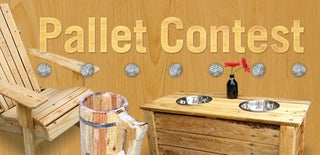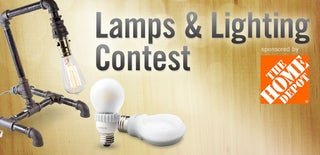Introduction: Pallet Wood Lamp
Perhaps you have a wooden construction pallet that you're trying to get rid of or are simply seeking a use for those pesky, shop-cluttering scrap boards in your garage. With a few dinged up boards, some basic lighting components, wing nuts and a tin can, I'll show you how to turn this junkyard pile into a sleek lamp that's perfect for a workshop or garage and (if you're man enough) maybe even your house too.
Supplies:
Pallet Wood
- (3) 6 inch boards
- (1) 2 foot board
- (1) 1 foot board
Plywood
- (1) 1 x 2-1/2 foot board (for base)
Hardware
- (4) 1-1/2 inch wood screws
- (3) #24 x 2 inch bolt with wingnut
- (2) #10 x 1-1/2 inch bolt with nut
- Tin can
Electrical
- Lamp wire (at least 10 ft.)
- Inline Switch
- Bulb Socket
- Electrical Plug
- Wire Caps
- Light Bulb
Tools
- Drill
- 3/8 inch bit
- 3/16 inch bit
- Wire Strippers
- Awl
Step 1: Screw the Two Footboards to the Base
Oops! I somehow managed to lose the pictures from the first couple of steps, but that's okay because it's pretty much self explanatory. Just take your two 6 inch foot boards and fasten them to the plywood base with a two 1-1/2 inch wood screws each. When you do this, be sure to begin each screw by drilling pilot holes with a 3/16 inch bit and space them one board width apart. To get the spacing perfect, sandwich the 2 foot long board between the feet when drilling.
Step 2: Attach the 2 Foot Long Board to the Feet
Place two foot long board between the two 6 inch feet and drill a 3/8 inch hole all the way through the boards. Insert a #24 x 2 inch bolt and tighten it down with a #24 wingnut.
Step 3: Attach the 1 Foot Board to the 2 Foot Board
Stack the 1 foot board on top of the 2 foot board and align their ends. Drill a 3/8 inch hole through the boards, insert a #24 x 2 inch bolt and tighten with a #24 wingnut.
Step 4: Punch Holes in the Tin Can
Using an awl (or a drill if you don't have one) punch two holes in the bottom of the tin can and two holes in the side. Space the holes on the side exactly 1-1/2 inches apart and keep them in a straight line.
Step 5: Drill Two Holes in the 6 Inch Board
Drill two 3/16 inch holes in the 6 inch board. Make them exactly 1-1/2 inches apart. This is important because they need to line up with the side-holes on the tin can.
Step 6: Attach the Tin Can to the 6 Inch Board
Place two #10 x 1-1/2 inch bolts through the 6 inch board. Thread the bolt ends through the holes in the tin can and then stuff your hand into the tin can to fasten nuts onto the bolts.
Step 7: Attach the 6 Inch Board to the 1 Foot Board
Stack the 6 inch board on top of the 1 foot board. Drill a 3/8 inch hole through both of the boards, insert a #24 x 2 inch screw between them and fasten it down with a #24 wingnut.
Step 8: Install a Bulb Socket
Take your bulb socket and strip the ends of its wires. Thread the wires through the two holes in the bottom of the tin can and tie them together to keep the bulb socket in place.
Step 9: Attach Lamp Wire to the Bulb Socket
Take the lamp wire and peel the ends apart (you can do this with a box cutter and a piece scrap wood). Strip the ends of the lamp wire and attach it to the bulb socket by twisting the frays. Twist wire caps over the frays to cover the exposed copper.
Step 10: Add an Inline Switch
Locate where you want the switch to go in the line and separate two inches of the lamp wire at that section with a box cutter (separate, don't cut!). Take the two screws out of the inline switch and pull it apart. Squeeze one of the separated wires into the bypass grove of the inline switch. Cut the other wire with your wire strippers and strip both ends. Wrap the frays of each end around their corresponding screws in a clockwise direction and tighten down the screws. Put cap back onto the inline switch and replace the screws.
Step 11: Install Electrical Plug
Take the electrical plug and cut the sheath away from the wires with a box cutter. Strip the ends of the wires (on both the plug and the lamp wire) and attach them to the lamp wire by twisting the frays in a clockwise direction. Twist wire caps over the exposed copper to complete the attachment.
Step 12: Screw in a Light Bulb
Insert a light bulb of your choosing, so long as it fits the bulb socket.
Step 13: Plug It In!
Plug it in and flip the switch. You can adjust the lamp into various configurations by loosening the wingnuts, adjusting the lamp and then tightening the wingnuts.

Participated in the
Pallet Contest

Participated in the
Lamps and Lighting












